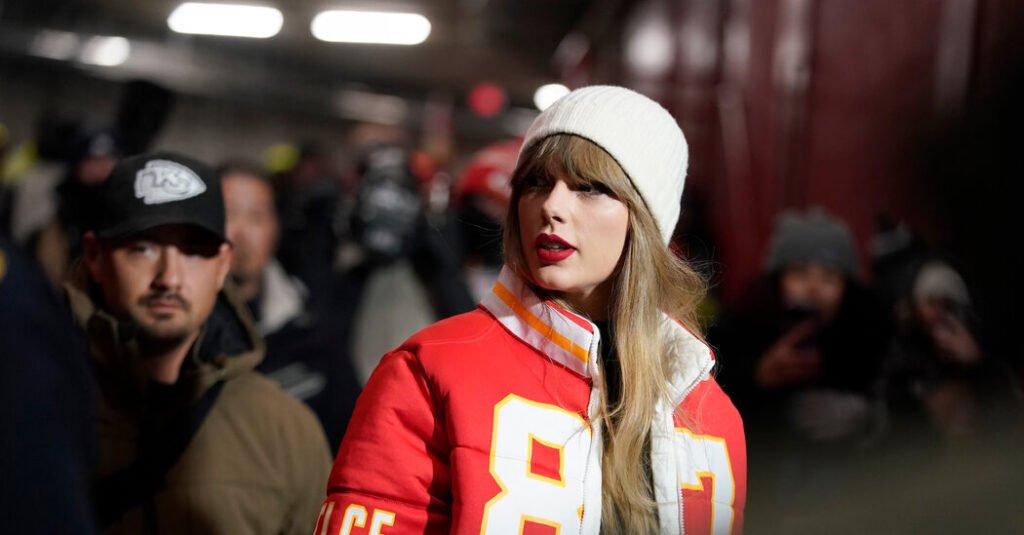Photographs of Taylor Swift that had been generated by artificial intelligence and had spread widely throughout social media in late January in all probability originated as a part of a recurring problem on one of many web’s most notorious message boards, in line with a brand new report.
Graphika, a analysis agency that research disinformation, traced the photographs again to 1 group on 4chan, a message board identified for sharing hate speech, conspiracy theories and, more and more, racist and offensive content material created utilizing A.I.
The individuals on 4chan who created the photographs of the singer did so in a form of recreation, the researchers mentioned — a take a look at to see whether or not they might create lewd (and typically violent) photos of well-known feminine figures.
The artificial Swift photos spilled out onto different platforms and have been considered millions of times. Followers rallied to Ms. Swift’s protection, and lawmakers demanded stronger protections towards A.I.-created photos.
Graphika discovered a thread of messages on 4chan that inspired individuals to attempt to evade safeguards arrange by picture generator instruments, together with OpenAI’s DALL-E, Microsoft Designer and Bing Picture Creator. Customers have been instructed to share “suggestions and tips to search out new methods to bypass filters” and have been advised, “Good luck, be artistic.”
Sharing unsavory content material via games permits individuals to really feel linked to a wider group, and they’re motivated by the cachet they obtain for collaborating, consultants mentioned. Forward of the midterm elections in 2022, teams on platforms like Telegram, WhatsApp and Fact Social engaged in a hunt for election fraud, profitable factors or honorary titles for producing supposed proof of voter malfeasance. (True proof of poll fraud is exceptionally rare.)
Within the 4chan thread that led to the faux photos of Ms. Swift, a number of customers acquired compliments — “lovely gen anon,” one wrote — and have been requested to share the immediate language used to create the photographs. One consumer lamented {that a} immediate produced a picture of a celeb who was clad in a swimsuit somewhat than nude.
Guidelines posted by 4chan that apply sitewide don’t particularly prohibit sexually express A.I.-generated photos of actual adults.
“These photos originated from a group of individuals motivated by the ‘problem’ of circumventing the safeguards of generative A.I. merchandise, and new restrictions are seen as simply one other impediment to ‘defeat,’” Cristina López G., a senior analyst at Graphika, mentioned in an announcement. “It’s essential to grasp the gamified nature of this malicious exercise as a way to stop additional abuse on the supply.”
Ms. Swift is “removed from the one sufferer,” Ms. López G. mentioned. Within the 4chan group that manipulated her likeness, many actresses, singers and politicians have been featured extra continuously than Ms. Swift.
OpenAI mentioned in an announcement that the express photos of Ms. Swift weren’t generated utilizing its instruments, noting that it filters out probably the most express content material when coaching its DALL-E mannequin. The corporate additionally mentioned it makes use of different security guardrails, equivalent to denying requests that ask for a public determine by identify or search express content material.
Microsoft mentioned that it was “persevering with to research these photos” and added that it had “strengthened our present security techniques to additional stop our companies from being misused to assist generate photos like them.” The corporate prohibits customers from utilizing its instruments to create grownup or intimate content material with out consent and warns repeat offenders that they could be blocked.
Pretend pornography generated with software program has been a blight since at the least 2017, affecting unwilling celebrities, government figures, Twitch streamers, students and others. Patchy regulation leaves few victims with authorized recourse; even fewer have a loyal fan base to drown out faux photos with coordinated “Defend Taylor Swift” posts.
After the faux photos of Ms. Swift went viral, Karine Jean-Pierre, the White Home press secretary, known as the scenario “alarming” and mentioned lax enforcement by social media corporations of their very own guidelines disproportionately affected ladies and women. She mentioned the Justice Division had not too long ago funded the primary national helpline for individuals focused by image-based sexual abuse, which the division described as assembly a “rising want for companies” associated to the distribution of intimate photos with out consent. SAG-AFTRA, the union representing tens of hundreds of actors, known as the faux photos of Ms. Swift and others a “theft of their privateness and proper to autonomy.”
Artificially generated variations of Ms. Swift have additionally been used to advertise scams involving Le Creuset cookware. A.I. was used to impersonate President Biden’s voice in robocalls dissuading voters from collaborating within the New Hampshire main election. Tech consultants say that as A.I. instruments change into extra accessible and simpler to make use of, audio spoofs and movies with life like avatars might be created in mere minutes.
Researchers mentioned the primary sexually express A.I. picture of Ms. Swift on the 4chan thread appeared on Jan. 6, 11 days earlier than they have been mentioned to have appeared on Telegram and 12 days earlier than they emerged on X. 404 Media reported on Jan. 25 that the viral Swift photos had jumped into mainstream social media platforms from 4chan and a Telegram group devoted to abusive photos of girls. The British information group Daily Mail reported that week {that a} web site identified for sharing sexualized photos of celebrities posted the Swift photos on Jan. 15.
For a number of days, X blocked searches for Taylor Swift “with an abundance of warning so we will ensure that we have been cleansing up and eradicating all imagery,” mentioned Joe Benarroch, the corporate’s head of enterprise operations.

